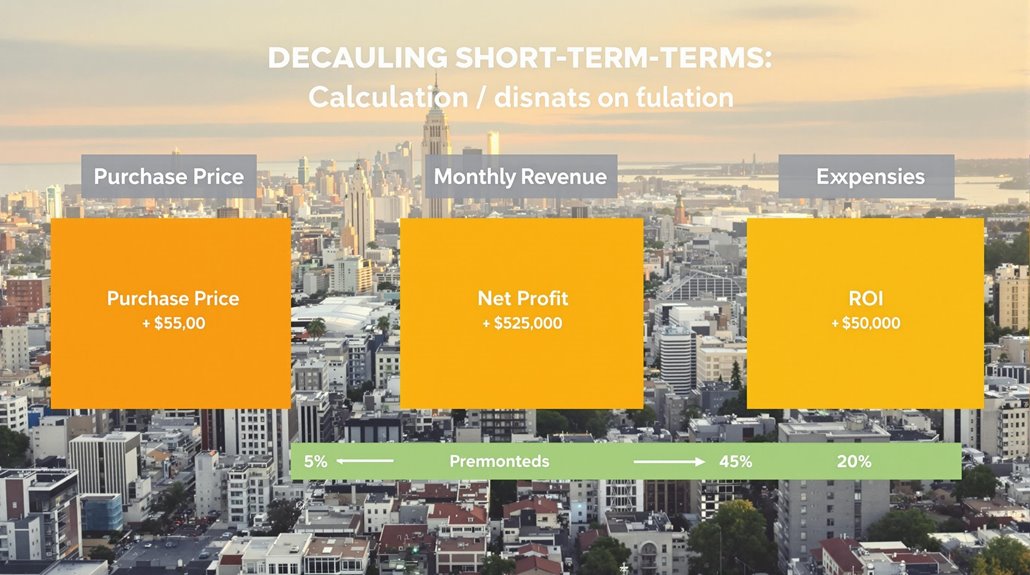To calculate short-term rental returns, start by estimating gross rental revenue using the average daily rate (ADR) and projected occupancy rate. Subtract operational expenses, which typically range from 20% to 40% of income, and maintenance costs at 1% to 3% of property value annually. Analyze net income and cash flow by monitoring occupancy and adjusting pricing strategies. Finally, determine ROI by dividing net revenue by total investment. Refining these calculations will enhance your financial insights.
Key Takeaways
- Calculate net operating income (NOI) by subtracting operating expenses from total rental income for accurate financial evaluation.
- Determine the capitalization rate (cap rate) by dividing NOI by the property’s purchase price to assess investment potential.
- Estimate gross rental revenue by multiplying the average daily rate (ADR) by the projected occupancy rate and total rental days.
- Analyze cash on cash return by dividing annual NOI by the actual cash invested to measure investment performance.
- Calculate ROI by subtracting total expenses from gross rental revenue and dividing by the total investment amount.
Understanding How to Calculate Short-Term Rental Returns
When evaluating short-term rental investments, it is essential to focus on key financial metrics that accurately measure performance and profitability. Start by calculating the net operating income (NOI), which is the total rental income minus operating expenses. This figure is foundational for determining a property’s cash flow efficiency. Next, determine the capitalization rate (cap rate) by dividing the NOI by the property’s purchase price. The cap rate provides a quick way to compare potential returns across similar properties in competitive markets. Additionally, analyze the cash on cash return, which measures the annual NOI relative to the actual cash invested. This metric reveals how effectively your initial capital generates income. Together, these metrics—NOI, cap rate, and cash on cash return—form a thorough framework for evaluating the financial viability of short-term rental investments, enabling you to make data-driven decisions. Keep in mind that seasonal fluctuations can significantly impact both occupancy rates and pricing strategies, making it essential to account for these variations in your financial analysis.
Estimating Gross Rental Revenue and Occupancy Rates
To estimate gross rental revenue for a short-term rental, you’ll multiply the average daily rate (ADR) by the projected occupancy rate and the total number of rental days annually, typically 365. For example, with an ADR of $150 and a 75% Airbnb occupancy rate, your gross rental revenue would be approximately $40,125 ($150 x 0.75 x 365). Accurately determining the ADR and occupancy rate requires researching comparable properties in your area, as these metrics vary by location and seasonality. Seasonal trends greatly influence occupancy rates, with peak periods often allowing higher rates. Adjusting your pricing strategy during these periods can optimize your gross rental revenue. Tools like the Airbnb Rentalizer calculator can help refine projections by analyzing local occupancy rates and historical performance data for similar properties. Dynamic pricing enhances rental income potential by enabling quick price adjustments based on market demand. This approach guarantees a more precise estimation of your short-term rental’s potential earnings.
Calculating Operational and Maintenance Expenses

Although estimating gross rental revenue is essential, accurately calculating operational and maintenance expenses is equally critical for determining the profitability of your short-term rental. Operational expenses typically range from 20% to 40% of your rental income and include utilities, internet, cleaning services, property management fees, and supplies. Maintenance expenses should be budgeted at 1% to 3% of the property’s value annually to cover repairs and regular upkeep. Seasonal fluctuations in costs, such as higher heating or cooling expenses, can impact your operational expenses and must be accounted for. Additionally, insurance for short-term rentals often costs $500 to $2,000 annually, depending on location and coverage. To guarantee accuracy, track these expenses consistently and adjust your budget as needed.
- Operational expenses: utilities, internet, cleaning, management fees (20–40% of rental income).
- Maintenance expenses: repairs and upkeep (1–3% of property value annually).
- Seasonal costs: fluctuating heating/cooling expenses.
- Insurance: tailored for short-term rentals ($500–$2,000 annually).
Analyzing Net Income and Cash Flow
Two key financial metrics for evaluating short-term rental profitability are net income and cash flow. Net income is derived by subtracting total operating expenses, including maintenance, cleaning, and utilities, from gross rental income. It reflects the property’s earnings after costs, providing a clear picture of operational efficiency. Cash flow, on the other hand, represents the actual cash available after all expenses, including fixed costs like mortgage payments and variable costs such as seasonal maintenance. It’s a critical measure of financial health, ensuring you can cover expenses and reinvest in the property. To maximize net income and cash flow, closely monitor occupancy rates, as higher bookings directly increase gross rental income. Additionally, adjust pricing strategies based on market trends to optimize potential income. Regularly reviewing these metrics helps you maintain profitability and identify areas for improvement in your short-term rental operations. Utilizing tools like the Long Term Rental Calculator can further enhance accuracy in financial projections and decision-making.
Determining Return on Investment (ROI) for Short-Term Rentals

When evaluating the profitability of a short-term rental, determining the return on investment (ROI) provides a clear measure of financial performance relative to your initial capital outlay. To calculate ROI for an investment property, subtract total expenses—including taxes, maintenance, and management fees—from gross rental revenue to determine net rental revenue. Divide this net revenue by your total investment amount. For instance, if your rental property generates $24,000 in gross revenue with $5,000 in expenses, net revenue is $19,000. With a $24,000 investment, the ROI is roughly 79.17%. Use a rental property calculator to streamline this process and account for seasonal trends and occupancy rates, which greatly impact returns. Consider seller financing or other creative financing options to minimize upfront costs and improve ROI potential.
- Calculate Net Revenue: Gross revenue minus total expenses.
- Divide by Total Investment: Net revenue divided by initial capital.
- Assess Occupancy Impact: Higher occupancy boosts ROI.
- Use a Calculator: A rental property calculator guarantees accuracy.
Conclusion
To calculate short-term rental returns, you’ll assess gross revenue, occupancy rates, and operational costs to determine net income. Deduct expenses like maintenance, utilities, and property management fees from gross revenue to analyze cash flow. Finally, compute ROI by dividing annual net income by your initial investment. By meticulously evaluating these metrics, you’ll uncover the financial viability of your rental property, ensuring informed decisions and optimized returns. Accuracy in these calculations is critical.




